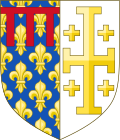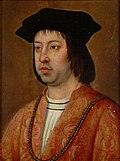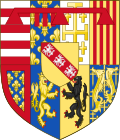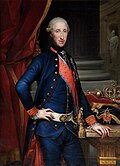Top Qs
Timeline
Chat
Perspective
List of Neapolitan monarchs
List of the monarchs of Naples From Wikipedia, the free encyclopedia
Remove ads
The following is a list of rulers of the Kingdom of Naples, from its first separation from the Kingdom of Sicily to its merger with the same into the Kingdom of the Two Sicilies.
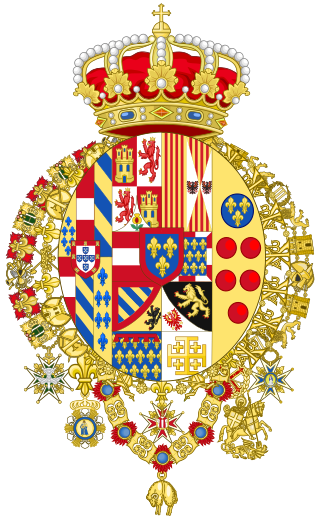
Kingdom of Naples (1282–1501)
Summarize
Perspective
House of Anjou
In 1382, the Kingdom of Naples was inherited by Charles of Durazzo, King of Hungary, great grandson of King Charles II of Naples. After this, the House of Anjou of Naples was renamed House of Anjou-Durazzo, when Charles married his first cousin Margaret of Durazzo, member of a prominent Neapolitan noble family.
House of Valois-Anjou (disputed)
Joanna of Naples had refused to name her enemy Charles of Durazzo as heir to the Neapolitan throne despite him ending up succeeding her anyway. If Charles' line was ignored, the subsequent heirs would be the descendants of Margaret, Countess of Anjou, a daughter of Charles II of Naples; the line pointed to the kings of France of the House of Valois. Joanna chose this line, though she named as heir, her second cousin once removed, Louis of Valois-Anjou, the second son of King John II of France, in order to avoid a personal union with France.
As Charles III had already seized the Neapolitan throne, initially the House of Valois-Anjou only had an empty claim. One of their members, Louis II, succeeded in ruling Naples for a time.
Time as claimant instead of actual rule will be shown in italic.
House of Anjou (restored)
House of Valois-Anjou (restored)
Joanna II recognised Louis III of Anjou as heir in 1423, however he died in 1434 before succeeding to the throne. His brother René of Anjou succeeded to the claim and became king upon Joanna's death in 1435.
House of Trastámara
Before Louis of Anjou, Queen Joanna II's adopted heir had been Alfonso V of Aragon. His father, Ferdinand I of Aragon had inherited both Aragon & Sicily from his maternal uncle Martin I of Aragon. Martin, in turn had claimed the throne of Sicily following the extinction of the Sicillian branch of the House of Barcelona, thereby bringing Sicily under the Aragonese crown. Alfonso refused to be disinherited and conquered Naples from René of Anjou in 1442. Although both Sicily & Naples were once again under the rule of the single monarch since the Sicillian Vespers, Alfonso passed the Aragonese throne (including Sicily) to his brother John, while Naples went to his illegitimate son Ferdinand.
Remove ads
Union with France (1501–1504)
Upon his death in 1480, René of Anjou transferred his claim to his nephew, Charles IV, Duke of Anjou. Charles died in 1481 and willed his claim to Louis XI of France. His son Charles VIII attempted to take Naples by force, but failed and died childless in 1498.
Charles VIII was succeeded by his 2nd cousin once removed Louis XII. Louis had no claim to the Neapolitan throne, but as successor to Charles VIII in France he nevertheless wanted to succeed him in Naples as well.
Naples was conquered in 1501 and became part of a personal union with the Kingdom of France. The local government was ruled by a French viceroy.
House of Valois-Orléans
Remove ads
Union with Spain (1504–1647)
Summarize
Perspective
Ferdinand II of Aragon conquered Naples from the French in the Treaty of Granada. Naples, alongside Sicily entered in a personal union with the Kingdom of Aragon, which lasted for over 2 centuries. Over time, the Crown of Aragon and the Crown of Castile merged to form the Monarchy of Spain, known colloquially as the "Kingdom of Spain", though the constituent crowns (Castile, Aragon, Sicily, Naples) retained their own institutions, and were ruled officially as separate states in personal union rather than as a unified state. The local government was ruled by a Spanish viceroy. The royal houses were:
- House of Trastámara (1504–1516)
- House of Habsburg (1516–1647)
House of Trastámara
Joanna III was kept confined under alleged insanity during her whole reign.
House of Habsburg
Neapolitan Republic (1647–1648)
House of Guise
Officially a Republic, Naples was governed for a short time by the Duke of Guise, under the title of "Doge of Naples".
Remove ads
Union with Spain (1648–1713)
Naples returned to its former status; in personal union with the Crown of Aragon and the Spanish monarchy.
House of Habsburg
House of Bourbon
Remove ads
Kingdom of Naples (1713–1799)
Under the terms of the Peace of Utrecht the crown of Naples passed to the Austrian Habsburgs.
House of Habsburg
House of Bourbon
In 1734 Spanish troops conquered the Kingdom of Naples, which was surrendered to Charles of Bourbon under the Treaty of Vienna (1738).
Remove ads
Parthenopean Republic (1799)
Dictators
Remove ads
Kingdom of Naples (1799–1816)
Summarize
Perspective
House of Bourbon-Two Sicilies
House of Bonaparte
House of Murat
House of Bourbon-Two Sicilies
Naples was merged with Sicily to form Kingdom of Two Sicilies.
Remove ads
See also
References
Wikiwand - on
Seamless Wikipedia browsing. On steroids.
Remove ads




